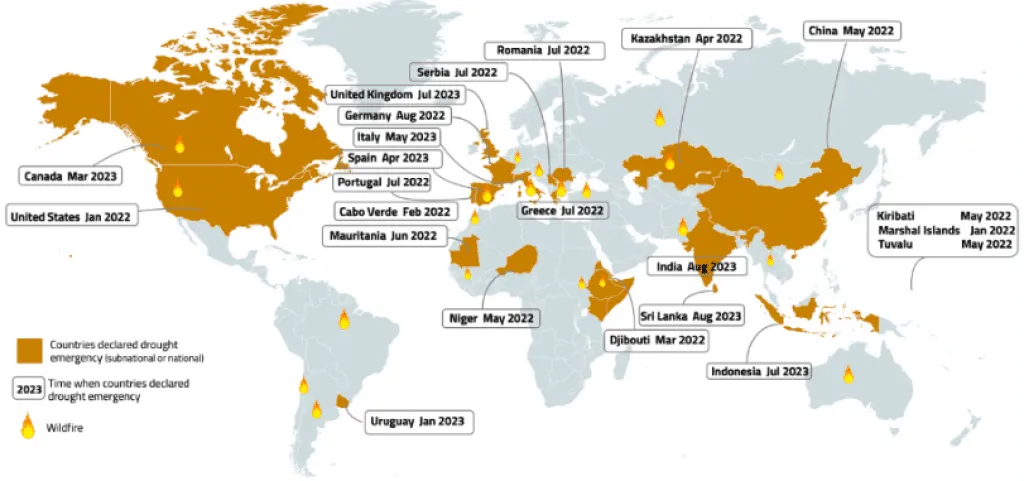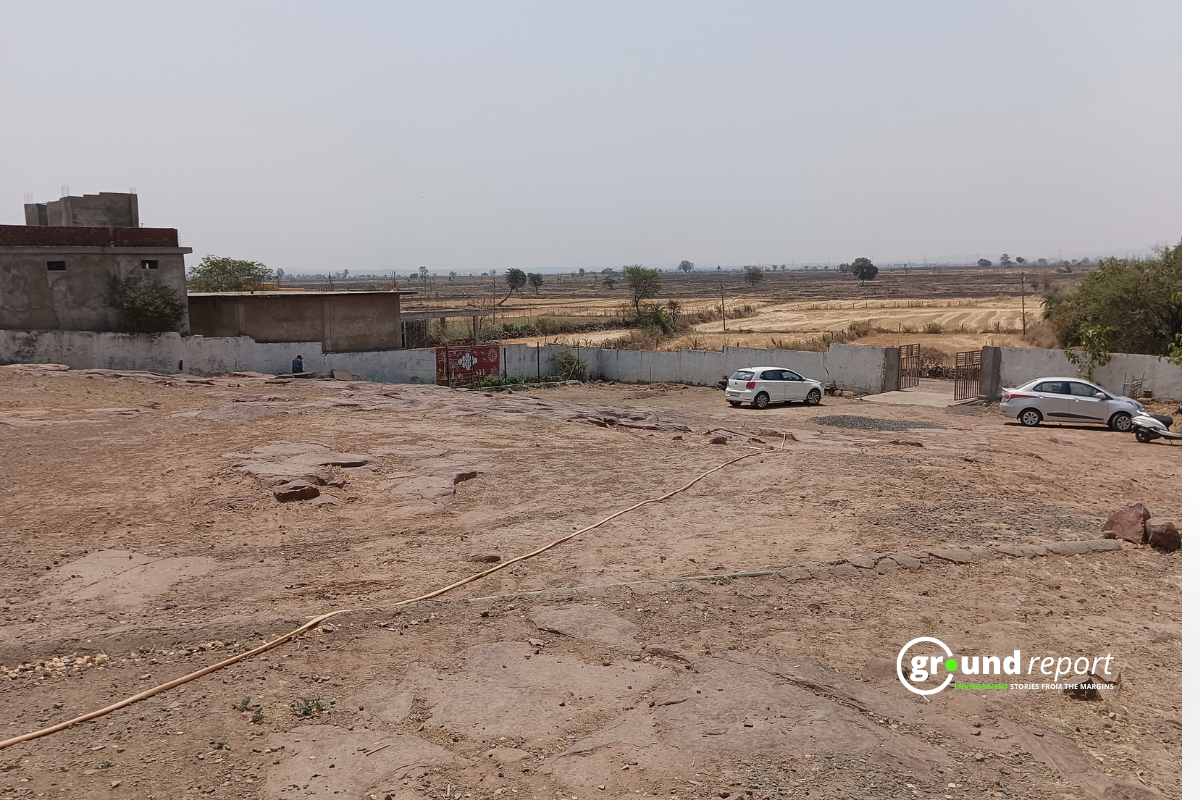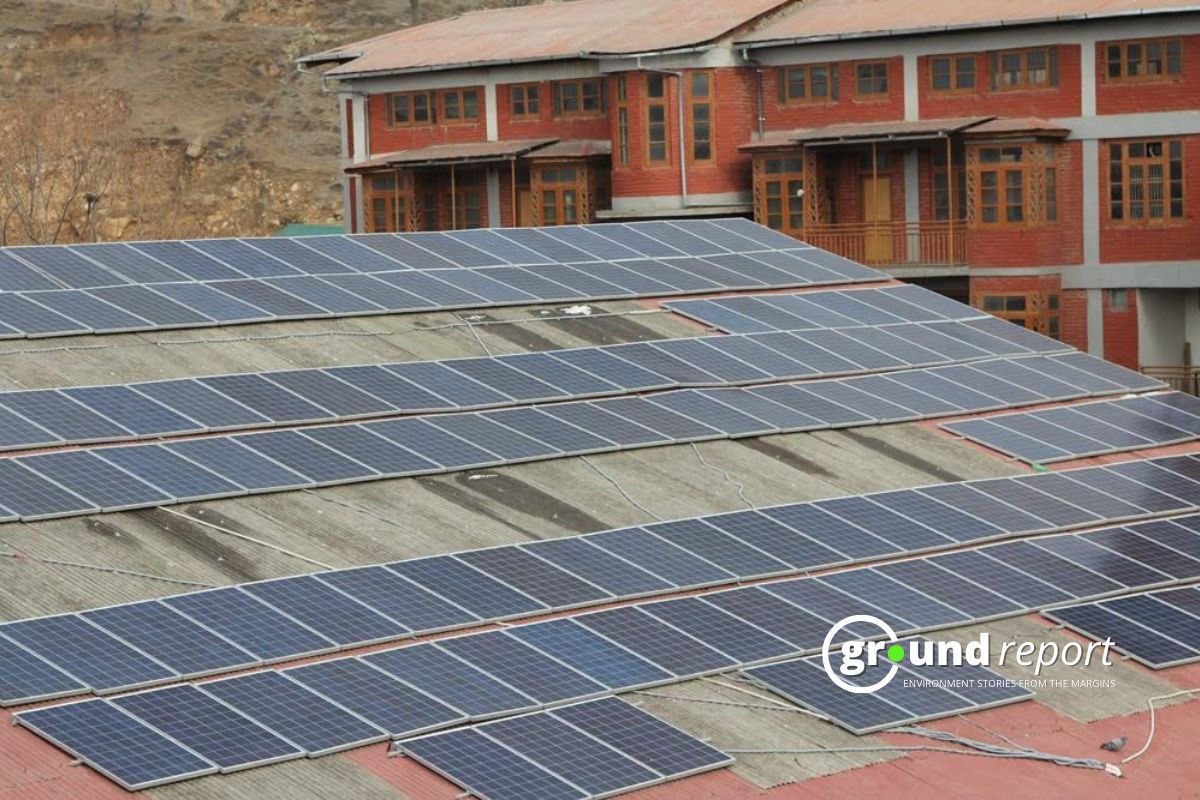The recent data from the United Nations’ global drought map, unveiled at the onset of the COP28 climate talks in Dubai, reveals a stark reality: 23 countries, including India, declared drought emergencies in 2022-23. This situation underscores the urgent need for global attention.
23 countries in emergency
By 2050, it is projected that droughts will impact three-quarters of the global population due to increased evaporation from warmer temperatures. In the US, 14% of the land area is currently experiencing severe to extreme drought conditions. Similarly, the Amazon rainforest has endured its driest period in 40 years, causing rivers to reach record low levels.
Despite the significant threat posed by droughts, they often receive insufficient attention from the media and governments, leading to what the UN describes as “silent devastation.” This lack of awareness exacerbates the challenges faced by those affected by these increasingly frequent and severe dry spells.
Droughts are among the most devastating natural hazards, claiming lives, causing significant economic losses, and impacting various societal sectors. The UN Convention to Combat Desertification (UNCCD) report indicates that 1.84 billion people were affected by drought, with 4.7% experiencing severe or extreme conditions.

“Unlike other disasters that attract media attention, droughts happen silently, often going unnoticed and failing to provoke an immediate public and political response. This silent devastation perpetuates a cycle of neglect, leaving affected populations to bear the burden in isolation,” said UNCCD Executive Secretary Ibrahim Thiaw. “We hope this publication serves as a wake-up call.”
Extreme heat
Europe saw the highest number of countries declaring emergencies, with eight nations including Spain, Italy, and the United Kingdom making such declarations in 2023, while Greece, Portugal, Romania, and Serbia did so in 2022. The continent experienced its hottest summers on record, with drought-affected areas reaching over 630,000 square kilometers in 2022, far exceeding the annual average since 2000.
The United States and Canada also declared drought emergencies in January 2022 and March 2023, respectively. In Asia, India, Sri Lanka, Indonesia, Kazakhstan, and China faced similar challenges.
The year 2023 has been marked by extreme heat, with the world surpassing the critical threshold of 2 degrees Celsius warming on November 17, 2023. This milestone, coupled with the new drought data, serves as a dire warning.

“We have no alternative to moving forward in a way that respects the planet’s boundaries and the interdependencies of all forms of life. We need to reach binding global agreements for proactive measures that are to be taken by nations to curtail the spells of drought,” the authors of the report stated.
Droughts have far-reaching consequences, from reduced water reservoir levels to lower crop yields, loss of biodiversity, famines, and severe economic impacts, particularly in agriculture-dependent regions. These conditions can lead to food shortages, price hikes, and disruptions in global food supply chains.
The economic toll of droughts is estimated to be billions of dollars annually. South American and African nations, as well as Pacific island countries like Kiribati, the Marshall Islands, and Tuvalu, also declared emergencies.
The Horn of Africa faced its worst drought in four decades, with Ethiopia, Kenya, and Somalia severely affected. This led to diminished agricultural productivity, food insecurity, and elevated food prices.
Drought data
- 15–20% of China’s population to face more frequent moderate-to-severe droughts in this century.
- An 80% expected increase in drought intensity in China by 2100.
- 23 million people deemed severely food insecure across the Horn of Africa in December 2022.
- 5% of the contiguous United States suffered severe to extreme drought in May 2023.
- 78 years since drought conditions were as severe as in the La Plata basin of Brazil–Argentina in 2022.
- 630,000 km2, roughly the combined area of Italy and Poland, was impacted by drought in Europe in 2022.
- 500 years since Europe last experienced a drought as bad as in 2022.
- 170 million people expected to experience extreme drought if average global temperatures rise 3°C above pre-industrial levels.
Agriculture and forests
- Drought damaged 70% of cereal crops in the Mediterranean during 2016–2018.
- South Africa experienced a 33% loss of grazing land due to drought.
- Forest losses in the Mediterranean region are expected to double or triple under 3°C warming compared to current risk.
- The Horn of Africa faced five consecutive rainfall season failures, leading to the region’s worst drought in 40 years, impacting Ethiopia, Kenya, and Somalia.
- Approximately 73,000 km2, or ~5% of EU cropland, was impacted by drought from 2000-2022, contributing to crop failures.
- Africa incurred $70 billion in drought-related economic losses over the past 50 years.
- Argentina is expected to see a 44% drop in soybean production in 2023, the lowest harvest since 1988/89, contributing to an estimated 3% GDP drop for the country.
Water conditions
- 75%: Reduction of cargo capacity of some vessels on the Rhine due to low river levels in 2022, leading to severe delays to shipping arrivals and departures.
- 5 million: People in southern China affected by record-low water levels in the Yangtze River due to drought and prolonged heat.
- 2,000: backlog of barges on the Mississippi River in late 2022 due to low water levels, causing $20 billion in supply chain disruptions and other economic damage.
- 2–5 times: Acceleration of long-term rates of groundwater-level decline and water-quality degradation in California’s Central Valley basins over the past 30 years due to drought-induced pumpage.
Social dimensions
- 85%: People affected by droughts who live in low- or middle-income countries.
- 15 times: Greater likelihood of being killed by floods, droughts and storms in highly vulnerable regions relative to regions with very low vulnerability, 2010 to 2020.
- 1.2 million: people in the Central American Dry Corridor needing food aid after five years of drought, heatwaves and unpredictable rainfall.
Remedies
- Nature-based solutions, including land restoration, could potentially offset up to 25% of CO2 emissions.
- Replacing half of animal products with sustainable alternatives could almost completely reduce the conversion of global forests and natural land for agriculture.
- Adopting micro-irrigation (drip irrigation) could lead to a potential 20 to 50% reduction in water waste compared to conventional sprinkler systems.
- The European Union aims to subject 20% of its land and sea areas to restoration measures by 2030, with a commitment to all ecosystems in need of restoration by 2050.
- AFR100 has invested $2 billion in African projects, with an additional anticipated investment of $15 billion to restore 20 million hectares of land by 2026, benefitting around 40 million people.
- Six riparian countries are part of the Volta Basin Flood and Drought management project, the first large-scale, transboundary implementation of Integrated Flood and Drought Management with an End-to-End Early Warning System.
- Approximately 45% of global disaster-related losses were insured in 2020, up from 40% in 1980-2018, but disaster insurance coverage remains low in many developing countries.
- Water distribution maps have improved to a 50 km resolution, thanks to a new method combining satellite measurements with high-resolution meteorological data, a significant upgrade from the previous 300 km resolution.
Keep Reading
- Sarbal a village in Kashmir buried in snow, How do people live here?
- Brown Bears living like pigs in Kashmir, eating garbage and plastics
Follow Ground Report for Climate Change and Under-Reported issues in India. Connect with us on Facebook, Twitter, Koo App, Instagram, Whatsapp and YouTube. Write us on GReport2018@gmail.com.









